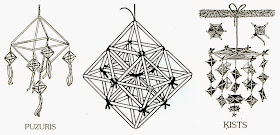For
Day Sixteen of 24 Days of a Baltic Christmas we welcome back Inga on the topic
of puzuri!
Puzuri and ķisti are among some of the oldest known Winter Solstice decorations
that ancient Balts made – and not only for Christmas, but for other special
life events, such as weddings, and to bring blessing and grace to a home. They are believed to be a symbol of
"wholeness", and their constant slow movement when hanging scares
away or traps evil spirits. As with
Native American dream catchers, they should be aired every so often, and burned
in the New Year's bonfire to guarantee an evil-free year. In different areas of
Latvia, they are also called lukturi,
krīģi, spurguļi; and other Scandinavian and Northern European countries
call them himmeli – from both Swedish
and German himmel (sky, heaven).
A
single puzuris is made of twelve segments, possibly representing the twelve
months of the year, and is a wonderfully simple Christmas tree decoration. To create a mobile hanging, puzuri of
different sizes may be combined by connecting corners, the end result limited
only by your imagination! Hanging from
the ceiling, the mobile spins and twirls with the slightest draft from opening
a door, walking by, warmth from candles, magically creating interesting
geometric patterned shadows.
 |
| The Lithuanian tree at the Museum of Science and Industry; a detail of a Lithuanian puzuris; the Chicago Latvian girl guide and boy scout volunteers with the Latvian tree at the museum. |
Traditionally,
puzuri were made of rye straw or reeds by grandmothers with their
grandchildren. The straw must be hollow
to allow threading. The straw or reeds
were gathered in the fall, carefully laid out to dry, then peeled of the papery
outer layer, any knots or ugly spots cut out. Straws must then be cut into segments, length
determined by the size of puzurs you are making. I find straws very difficult to cut without
damaging, and after trying every implement from embroidery scissors to box
cutters to single edge razor blades, I found that soaking the straws overnight
makes them stronger and less prone to split. After soaking, I was able to cut
them with a sharp pair of small scissors with little loss. Inherently fragile, working with straw
requires patience and a steady hand. Beginner puzuri-makers may use paper or plastic straws (like those tiny
coffee stirrers?), as these will be sturdier and less apt to split or bend, and
paper or plastic straw is easier to find than natural straw. Colored thread or yarn, feathers, twists or
cut-outs of paper, even bits of eggshell are used as embellishment – there are
no rules, other than to use what you have at hand!
To make one puzuris, you will
need:
12 straw segments of equal length,
a piece of thin yarn or embroidery thread a bit longer than the combined length of
all 12 straws,
a longish needle thin enough to fit through hollow straw,
colored thread or yarn, scraps of fabric, twists or cut-outs of paper for
embellishment
1)
Thread three straws, knot.
2)
Add two more straws, secure at corner.
3)
Add two more, secure again.
4)
Add two more straws, secure at corner.
5)
Add one straw, secure at corner as shown – puzuris
starts becoming three-dimensional!
6)
Secure the corner – one half of your puzuris
is complete.
7)
Thread one more straw and secure as shown.
8)
Add the final straw as shown, and knot the end to the beginning!
There
are many other decorations that can be made with straw, but the easiest might
be a chain to hang over a doorway, or around your tree by threading straws
alternating with cut paper (or birch-bark, if you happen to have some handy)
shapes – as long or short as you like.
Another
type of chain – simply keep adding triangles!
Sources for purchasing natural
straw:
Nova Natural
Thank you Inga! All illustrations are from "Vārdu klētiņa" by Inese Ruberte (Zvaigzne ABC 1997). For more information on The Museum of Science and Indstry and the Christmas Around the World and Holidays of Light exhibit, please visit the MSI website. If in the Chicago area make sure to stop in and visit the Baltic Christmas trees! Tomorrow on 24 Days of a Baltic Christmas, a Lithuanian Christmas recipe...







These are super cool, we're going to try to make them!
ReplyDeleteEven if you use drinking straws, the end result is pretty! I think if I tried with the boys I might use a shoestring and penne pasta...
DeleteI bet pasta would be an interesting variation on the theme! Plus - you could paint them!
ReplyDeletedazzling and vibrant fotografia !
ReplyDelete